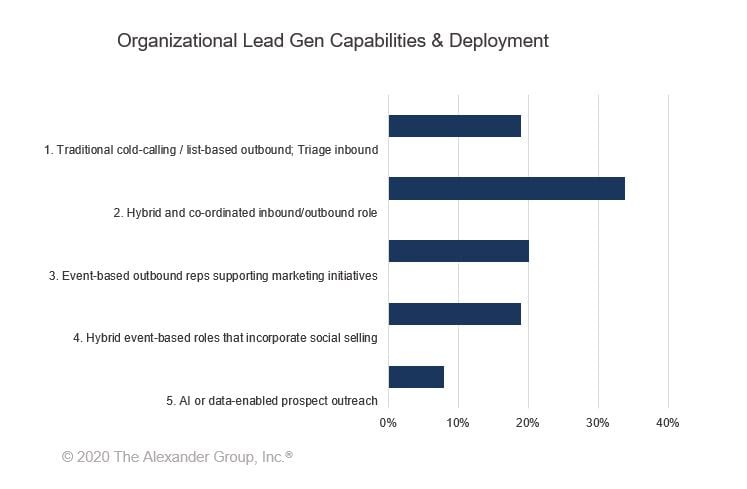Next Gen Lead Gen: A Roundtable Summary
The Alexander Group recently hosted 99 revenue leaders at a virtual roundtable to discuss emerging trends in lead generation practices.
The discussion used materials from the Alexander Group custom study on lead generation and focused on three key areas:
- Role Scope & Deployment: What scope of roles support lead generation activities, and how are those roles evolving as prospecting efforts grow more sophisticated with data and technology available?
- Customer Engagement & Messaging: How is the buyer journey changing and how is online research and the use of social media changing the status quo, forcing changes to the messaging, the cadence and touchpoint strategy of efforts?
- Tools & Technology: Which new technologies have companies deployed to boost productivity in their lead generation engine?
This article outlines the key trends and practices used by participants to drive improved lead generation in their business.
Role Scope & Deployment
Research by the Alexander Group shows many companies shifting to a hybrid inbound / outbound lead generation role with less focus on cold calling and more emphasis on warm contacts. Roundtable participants structure their teams in a multitude of different ways with leading companies in the space augmenting lead generation efforts.
Upskilling of Lead Gen Reps: One leader cited an increased investment in dedicated workflow training for lead generation reps to meet customer desires for more technical conversations upfront.
Farming leads from new sources: Companies have assigned some reasonability for cross-sell/ upsell to technical sellers or CSMs. Citing a high yield for add-on opportunities from technical sellers, one global pre-sales leader shared an initiative launched to establish prospecting accountability for this constituency. More specifically, the organization started recognizing and rewarding the technical community for their work. The initiative proved successful in driving quality leads into the sales funnel.
The impact of COVID-19 on lead volumes has pushed companies to cast a wider net for leads with many taking additional actions to find more volume.
Asking core field sales reps to conduct prospecting: Many leaders have observed teething issues with the change. The pivot towards the digital sales model among many long-tenured field reps has, in some cases, resulted in lower productivity than their digitally native counterparts. Remedying this, companies are pairing field reps with experienced sellers to transfer skills and knowledge.
Refocusing marketing efforts on demand gen: Several participants shared the expansion of demand generation through virtual events in lieu of in-person events. One leader shared that a sub-set of their reps have even sponsored remote happy hours. However, virtual events are a balancing act as roundtable participants have reported a drop in attendance and ‘event fatigue.’ Remedying this is a key priority going forwards.

Customer Engagement & Messaging
The volume of messaging a customer or prospect interacts with is expanding exponentially due to social media, increased focus on digital events (both company and industry sponsored) and more advanced online marketing savvy. Companies are also investing heavily to determine how to match contacts with the right messaging at the right time. Best-in-class companies are accessing prospects earlier in the cycle with a blended digital and social selling approach. Furthermore, employing usage data and AI to find and better target cohorts of potential high customer lifetime value (CLV) targets also came up as a differentiator. Digitally enabling the lead generation function to do this is critical to effective contact management.
Expand marketing efforts in target segments: One sales leader at a cloud infrastructure company aligned their marketing spends (ads, outreach, events, etc.) with specific target sales prospects. By warming the prospects through marketing efforts they have found the customer more likely to buy.
Use data to prioritize outreach efforts: The CMO at large tech company led an initiative to use intent data gathered from website interactions and AI to prioritize dollars and prospects. By building predictive models on customer propensity, this company is seeing higher ROI on lead gen efforts.
Invest in data quality: A leading data center company is investing in software to align sales and marketing contacts into a single data set to improve cohesion between the teams. Refreshing the data is critical to the effort to ensure contacts stay relevant during this particularly volatile time. Other companies noted that they are amending internal processes to prioritize data quality. One sales leader illustrated the creation of a time policy for contacts in which those with no activity for 90 days are flagged and reviewed for accuracy. The outcome of this work has resulted in better open rates and lead volumes.
A/B test sequencing and messaging: “Content is King” – companies are increasingly utilizing A/B testing to find content and deliver mechanisms that meet prospect needs. One participant uses A/B tests on the number of touches a prospect gets over a 20-day period to find trends among prospect and customer cohorts, while another participant tests open rates and email subject lines. Roundtable participants agree that measuring success needs to come from an accurate baseline – agreeing on this upfront with all stakeholders allows for more coordinated efforts.
Tools & Technology
Investing in the right tools and technology for your lead generation organization is a key factor in their success. Alexander Group research has found a strong positive correlation in the tool investment and lead generation productivity, but many revenue leaders note a dissatisfaction in their technology usage effectiveness.
Buy tools that fit your model: Companies reliant on calls have invested in dialers: phone-based software that automates calls, logging and coaching. Companies with a strong email bias have invested in sequence management software and A/B testing.
Integrate tools to create a data ecosystem: Companies are supercharging lead generation efforts through their integrated enterprises data ecosystems. With marketing, sales and product data in a seamless package, companies have built better forecasting models for customer prioritization and improved open rates for emails by ensuring the right prospects get the right information. Internally, simple fixes are saving lead generation rep time; a leading services company writes call data into CRM automatically and frees up rep time for calls.
Educate reps: Leading companies check utilization rates for technology investments and take coaching action when reps are not fully utilizing investments. Education and upskilling reps in digital tools have become a mission critical task with the acceleration of digital working in the past five months, and market leaders have allocated time to get it right.
A fool with a tool is still a fool: As one sales leader noted, before investing in technology, companies must do the hard work of aligning people and processes within the organization. Supporting poor processes with good technology minimizes the impact of investments and often results in higher spend and continued poor performance.
Lead generation is undergoing a digital transformation and companies that have successfully aligned their messaging, processes and tools are at the forefront of this growth. To learn more and join the conversation, please contact Alexander Group to schedule a complimentary lead generation briefing, or register for one of our upcoming virtual roundtable series.


